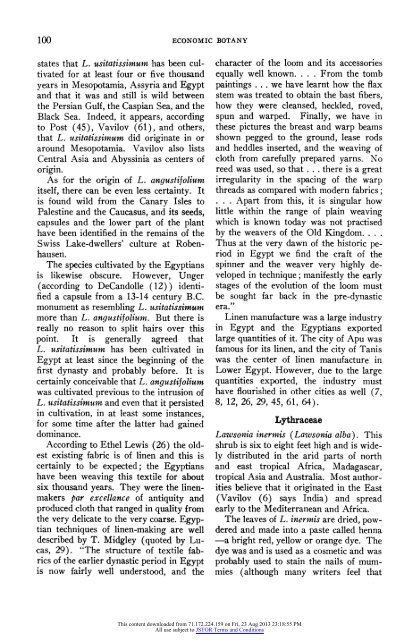The Botanical Aspects of Ancient Egyptian Embalming and Burial
The Botanical Aspects of Ancient Egyptian Embalming and Burial
The Botanical Aspects of Ancient Egyptian Embalming and Burial
You also want an ePaper? Increase the reach of your titles
YUMPU automatically turns print PDFs into web optimized ePapers that Google loves.
100 ECONOMIC BOTANY<br />
states that L. usitatissiimum has been cultivated<br />
for at least four or five thous<strong>and</strong><br />
years in Mesopotamia, Assyria <strong>and</strong> Egypt<br />
<strong>and</strong> that it was <strong>and</strong> still is wild between<br />
the Persian Gulf, the Caspian Sea, <strong>and</strong> the<br />
Black Sea. Indeed, it appears, according<br />
to Post (45), Vavilov (61), <strong>and</strong> others,<br />
that L. usitatissimum did originate in or<br />
around Mesopotamia. Vavilov also lists<br />
Central Asia <strong>and</strong> Abyssinia as centers <strong>of</strong><br />
origin.<br />
As for the origin <strong>of</strong> L. angustifolium<br />
itself, there can be even less certainty. It<br />
is found wild from the Canary Isles to<br />
Palestine <strong>and</strong> the Caucasus, <strong>and</strong> its seeds,<br />
capsules <strong>and</strong> the lower part <strong>of</strong> the plant<br />
have been identified in the remains <strong>of</strong> the<br />
Swiss Lake-dwellers' culture at Robenhausen.<br />
<strong>The</strong> species cultivated by the <strong>Egyptian</strong>s<br />
is likewise obscure. However, Unger<br />
(according to DeC<strong>and</strong>olle (12)) identified<br />
a capsule from a 13-14 century B.C.<br />
monument as resembling L. usitattissimum<br />
more than L. angustifolium. But there is<br />
really no reason to split hairs over this<br />
point. It is generally agreed that<br />
L. usitatissimum has been cultivated in<br />
Egypt at least since the beginning <strong>of</strong> the<br />
first dynasty <strong>and</strong> probably before. It is<br />
certainly conceivable that L. angustifolium<br />
was cultivated previous to the intrusion <strong>of</strong><br />
L. usitatissimum <strong>and</strong> even that it persisted<br />
in cultivation, in at least some instances,<br />
for some time after the latter had gained<br />
dominance.<br />
According to Ethel Lewis (26) the oldest<br />
existing fabric is <strong>of</strong> linen <strong>and</strong> this is<br />
certainly to be expected; the <strong>Egyptian</strong>s<br />
have been weaving this textile for about<br />
six thous<strong>and</strong> years. <strong>The</strong>y were the linenmakers<br />
par excellance <strong>of</strong> antiquity <strong>and</strong><br />
produced cloth that ranged in quality from<br />
the very delicate to the very coarse. <strong>Egyptian</strong><br />
techniques <strong>of</strong> linen-making are well<br />
described by T. Midgley (quoted by Lu-<br />
cas, 29). "<strong>The</strong> structure <strong>of</strong> textile fabrics<br />
<strong>of</strong> the earlier dynastic period in Egypt<br />
is now fairly well understood, <strong>and</strong> the<br />
character <strong>of</strong> the loom <strong>and</strong> its accessories<br />
equally well known. . . . From the tomb<br />
paintings . . . we have learnt how the flax<br />
stem was treated to obtain the bast fibers,<br />
how they were cleansed, heckled, roved,<br />
spun <strong>and</strong> warped. Finally, we have in<br />
these pictures the breast <strong>and</strong> warp beams<br />
shown pegged to the ground, lease rods<br />
<strong>and</strong> heddles inserted, <strong>and</strong> the weaving <strong>of</strong><br />
cloth from carefully prepared yarns. No<br />
reed was used, so that . . . there is a great<br />
irregularity in the spacing <strong>of</strong> the warp<br />
threads as compared with modern fabrics;<br />
. . . Apart from this, it is singular how<br />
little within the range <strong>of</strong> plain weaving<br />
which is known today was not practised<br />
by the weavers <strong>of</strong> the Old Kingdom....<br />
Thus at the very dawn <strong>of</strong> the historic period<br />
in Egypt we find the craft <strong>of</strong> the<br />
spinner <strong>and</strong> the weaver very highly developed<br />
in technique; manifestly the early<br />
stages <strong>of</strong> the evolution <strong>of</strong> the loom must<br />
be sought far back in the pre-dynastic<br />
era."<br />
Linen manufacture was a large industry<br />
in Egypt <strong>and</strong> the <strong>Egyptian</strong>s exported<br />
large quantities <strong>of</strong> it. <strong>The</strong> city <strong>of</strong> Apu was<br />
famous for its linen, <strong>and</strong> the city <strong>of</strong> Tanis<br />
was the center <strong>of</strong> linen manufacture in<br />
Lower Egypt. However, due to the large<br />
quantities exported, the industry must<br />
have flourished in other cities as well (7,<br />
8, 12, 26, 29, 45, 61, 64).<br />
Lythraceae<br />
Lawsonia inermis (Lawsonia alba). This<br />
shrub is six to eight feet high <strong>and</strong> is widely<br />
distributed in the arid parts <strong>of</strong> north<br />
<strong>and</strong> east tropical Africa, Madagascar,<br />
tropical Asia <strong>and</strong> Australia. Most authorities<br />
believe that it originated in the East<br />
(Vavilov (6) says India) <strong>and</strong> spread<br />
early to the Mediterranean <strong>and</strong> Africa.<br />
<strong>The</strong> leaves <strong>of</strong> L. inermis are dried, powdered<br />
<strong>and</strong> made into a paste called henna<br />
-a bright red, yellow or orange dye. <strong>The</strong><br />
dye was <strong>and</strong> is used as a cosmetic <strong>and</strong> was<br />
probably used to stain the nails <strong>of</strong> mummies<br />
(although many writers feel that<br />
This content downloaded from 71.172.224.159 on Fri, 23 Aug 2013 23:18:55 PM<br />
All use subject to JSTOR Terms <strong>and</strong> Conditions
















